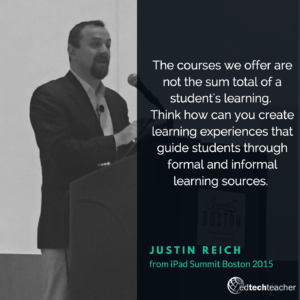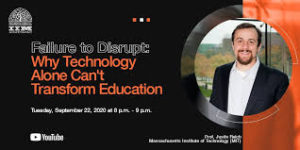Not two weeks ago, I was presenting to the faculty on Digital Transformation, and my comment that I hope my colleagues took from it was that a Digital Transformation is, at its core, a very human endeavor. This book supports this whole-heartedly by reviewing the history of big claims and myths about the saviour-syndrome of EdTech; it highlights the critical role that educators play in navigating and stewarding the learning experiences – digital and otherwise – of their students; and, it encourages educators to be the lead digital learners/navigators alongside their students.
The arrival of new digital tools and systems can be an opportunity to open up a new dialogue about the role that educators play in the learning journey of their students, and of themselves. Justin writes:
The arrival of new learning technologies can be an invitation for communities of educators to look up from their critically important and engrossing day-to-day work and to imagine how a new tool might reinvigorate their practice. (Pg. 245)
This is a book that debunks the myths, the hype and claims about how technology will revolutionize, democratize and make more equitable the outcomes of education. To a certain extent, it is about how people who benefit from educational technology are generally people who have institutionally, historically and systemically always been set up for success.
In 1913, Thomas Edison declared that the age of books was about to give way to the age of motion pictures. He told an interviewer, “Books will soon be obsolete in the public schools…” [He claimed that] Our school system will be completely changed inside ten years. – Pg. 229
Since 1913, claims such as these have been made, but then ultimately absorbed into the system, the institutions that is our systems of education, without any radical change towards personalized learning for students, nor a strategic shift in how teachers position themselves in their learning journey. As schools undergo an unprecedented digital transformation, accelerated by the global pandemic, this books provides an excellent perspective, strategies and mindsets for a responsible approach to Digital Transformation.
You’d be interested in this book if…
1) You are leading digital transformation in education
2) You have questions and concerns about the long digital shadow cast by students’ data collection
3) You want a survey approach to disruptive educational approaches, where they went, why they did/did not work
4) You want to ask strategic questions to support responsible integration with educational technology.
5) You are an educator who does or doesn’t use technology
Charlatan vs. Tinkerer
Painting educational technology leaders, companies and investors as charlatans is a weakness of this book, but it makes his point – that a digital transformation is best contextualized as a “Tinkering” with tools, experiences and approaches. In this way, educators are in the position of kindling the flame of education, and not just filling pails. (pg. 111) For example, this quotation on personalized learning:
The consensus about the great potential of personalized learning depended on a stark disagreement about what the term actually meant…For [pail-fillers] personalization meant that each individual child would be able to spend part or all of her day proceeding through technology-mediated learning experiences at her own pace. For other educators, it wasn’t the pace that should be personalized; it was the content and learning experiences..[by] leveraging online networks to explore their own interests. Students would identify passions, join online learning communities, study topics of their choosing and create performances and artifacts of their learning… – Pg. 77
By pitting these two philosophical approaches to educational technology’s role in the education system, this book is able to deep-dive into the hurdles, the unmet promises, and develop strategies and solutions to understand how a digital transformation can be successful in education.
Minecraft & Scratch vs. MathBlaster & Naviance
This book addresses some widely adopted software (like Mathblaster and Naviance) and traces their hype, their potential and their ultimate shortcomings. For example, Mathblaster is an “…instructor-guided games exist[ing] on a walled garden platform or inside a software package or app, assess student performance and progress through pattern-matching autograders, and draw pedagogical inspiration from pail fillers rather than flame kindlers.” (pg. 111) And Naviance is held up as an example of potentially toxic data collection: “Enter Naviance, which aggregates data about colleges, students, and high schools to provide algorithmically generated advice.” But there is the potential for dangerous data-matching and layering to occur (like race or other dimensions of socio-economic status) that can lead to the continued “reinforce[d] historically inequitable patterns.” (pg. 217)
These are powerful analysis of technology being integrated without the ability for systems to take into account how they might be leveraged for positive outcomes, and integrated responsibly to account for potential harms.
The book also addresses how incredibly personalized platforms for learning, like Minecraft and Scratch, begun with hype that was to revolutionize informal learning.These platforms allow for learners to follow their patterns, connect to networks and create. However, when they are integrated into the educational system, they have become ‘institutionalized’ and lose their appeal:
The disjunction between the culture of informal online learning and the culture of formal educational systems means that schools struggle to integrate peer-guided, interest-driven technologies…[these systems] domesticate new technologies, and in most cases, they use such technologies in the service of the well-established goals and structures of schools. (pg. 237)
Knowing that educational technology has limitations within formal schools, and informal learning has powerful potential, leads to strategies and key questions.
Shifting the Narrative
After a lengthy and well researched review of the history, there are a few key points that the book highlights:
1) Change won’t come from EdTech heroes
2) Technology won’t transform teaching and learning
3) We need to let go of hoping for (1) and (2)
After a century of edtech hype cycles, my dream is that educators will now have enough experience, through data, and enough history at their disposal to defend against the next wave of overly optimistic claims by crafting their own more realistic, historically grounded prediction for the future of learning at scale. (Pg. 232)
How might we strengthen this narrative and up-skill teachers to be the lead learners with EdTech?
Educators can never be replaced by computers. They simply can’t. Artificial Intelligence (autograders, etc…) vs. the human brain will not win, at least not in my lifetime. Educators have the ability, the training and skills to work with their students to find their passions, develop interesting questions, and inspire. Technology simply does not.
So how might we put technology in the hands of our educators to amplify what they can do so well?
Asking the Right Questions:
In order to amplify our educators capability, and our learners efficacy, we need to ask great questions of the digital transformation that we are proposing. The book provides key questions to support a positive, intentional and responsible digital transformation:
1) What is new?
2) Who is guiding the learning experience?
3) Pedagogically, is this attempting to fill a pail, or kindle a fire?
4) What existing technologies does this adopt?
5) And, how will existing stakeholders in a learning ecosystem see this technology? In particular, how will they use it to extend exisiting practices?
6) What kinds of learning can and cannot be assessed with this technology?
7) How would learners from different backgrounds and different life circumstances access of use these technologies differently?
8) How could experimentation and data analysis improve this technology, and how might those data collection and experimentation efforts contribute to a culture of surveillance?
Also, we need to partner with our community of families, businesses and partners and others to heighten our networked learning opportunities.
“People who do stuff do more stuff, and people who do stuff do better than people who don’t do stuff.” – Justin Reich (218)
This is Justin Reich, though in humour, summarizing the learning outcomes of MOOCs with a simple rule he calls Reich’s Law. And as a commentary on educational technology’s impact on learning, he is not far wrong.
Data Privacy
I was really impressed with how this book examines the data privacy issues within EdTech. Justin has been a part of data collection and mining for quite some time and in this book explains his level of discomfort, as well as his rationalization, for why and how he has been using the data.
For critics, forcing students to participate in widespread data collection is training them for docile acceptance of participation in the surveillance capitalism of advertising technology networks and the growing surveillance state. (pg. 207)
He provides an example from Rutger’s University and their use of Proctortrack, where, when some students protested over the use of this piece of software that monitors faces and knuckles, the University charged them money to have a human proctor. There are lessons that are yet to be learned from the injection of large tech companies into the education space. Mindful, careful and transparent processes are required to ensure that students data is not creating an inequitable future.
He notes that harms are possible from major data leaks and breaches that have happened in recent past. As well, harm can come from “…well-meaning attempts to use data to support student learning.” (pg. 215) We must be stewards of the present, as well as the future for our students and entire communities.
The time has come to rethink our guidelines for the collection, storage and use of student data. (Pg. 209)
The arrival of new learning technologies can be an invitation for communities of educators to look up from their critically important and engrossing day-to-day work and to imagine how a new tool might reinvigorate their practice. (Pg. 245)



“People who do stuff do more stuff, and people who do stuff do better than people who don’t do stuff.” – Justin Reich (218) Hah, I love this quote. Though, point well taken that just doing stuff isn’t good enough, but has to be paired with the right questions. Questioning filling the pail vs. kindling the fire is a great one (and really well put, I’ve never heard it posed this way before) because I think there is a tendency (for me at least) to presume that fancy new ed techs do the latter. But, we have to intentionally question that more.
Thanks for this book review!
Esther